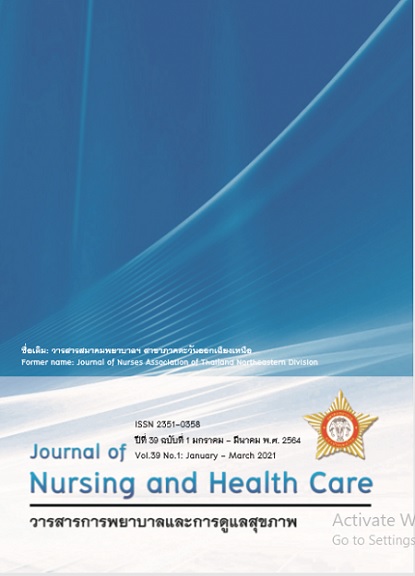การประยุกต์ใช้แนวคิดสมรรถนะเชิงวิชาชีพที่สามารถปฏิบัติได้ โดยไม่ต้องกำกับดูแลในการพัฒนาสมรรถนะด้านทักษะของพยาบาลวิชาชีพ
คำสำคัญ:
สมรรถนะวิชาชีพ, ทักษะพิสัย, การพยาบาลบทคัดย่อ
การศึกษาพยาบาลในปัจจุบันมีข้อจำกัดของเวลาในการศึกษาเนื้อหาและการปฏิบัติงาน1 การศึกษาพยาบาลโดยใช้
สมรรถนะเป็นฐาน (Competency based education) จึงเป็นการเรียนการสอนเพื่อให้มั่นใจว่าผู้เรียนมีความรู้ ทักษะและ
ทัศนคติ (Knowledge, skill, attitude: KSAs) ในการปฏิบัติงาน2 สมรรถนะวิชาชีพการพยาบาลที่เกิดขึ้นจะต้องเกิดจากการ
ปฏิบัติโดยตรงมากกว่าการสังเกตการปฏิบัติในคลินิก การประเมินสมรรถนะของพยาบาลที่จบใหม่มีช่องว่างระหว่าง
ความคาดหวังต่อสมรรถนะ และสมรรถนะการพยาบาลที่เกิดขึ้นจริงที่ไม่สอดคล้องกัน และในความเป็นจริงแล้วสมรรถนะ
วิชาชีพด้านทักษะที่คาดหวังกับสมรรถนะที่เกิดขึ้นจริงมีความแตกต่างกัน3,4 กิจกรรมการปฏิบัติทางวิชาชีพที่เชื่อมั่นได้โดยไม่
ต้องกำกับดูแล (Entrustable professional activities: EPAs) เป็นแนวคิดที่ใช้ในวงการศึกษาเพื่อพัฒนาทักษะผู้เรียน
แต่สามารถนำมาประยุกต์กับการพัฒนาสมรรถนะด้านทักษะของพยาบาลวิชาชีพได้ เพื่อให้พยาบาลวิชาชีพพร้อมที่จะ
ให้การดูแลผู้รับบริการให้มีคุณภาพที่ดี ผู้รับบริการปลอดภัยและมีความเชื่อมั่นในการให้บริการ5 และลดช่องว่างระหว่าง
สมรรถนะวิชาชีพด้านทักษะที่คาดหวังกับทักษะที่เกิดขึ้นจริง บทความนี้มีวัตถุประสงค์เพื่อเสนอแนวคิด (Concept) ในการ
พัฒนาสมรรถนะเชิงวิชาชีพที่สามารถปฏิบัติได้โดยไม่ต้องกำกับดูแล และนำเสนอขัน้ ตอนการพัฒนา EPAs สำหรับพยาบาล
วิชาชีพที่ได้จากการทบทวนวรรณกรรม
Downloads
เอกสารอ้างอิง
2. Pijl-Zieber EM, Barton S, Konkin J, Awosoga O, Caine V. Competence and competency-based nursing education: Finding our way through the issues. Nurse Education Today 2014; 34(5): 676–678.
3. Anusornteerakul S, Tienprasert S, Kanchanabatr B. Entrustable professional activities on psychomotor skills among newly graduated nurses. Journal of Nursing and Health Care 2020; 38(1): 69-77. (in Thai)
4. Giddens JF, Lauzon Clabo L, Morton PG, Jeffries P, McQuade Jones B, Ryan S. Re-envisioning clinical education for nurse practitioner programs: Themes from a national leaders’ dialogue. Journal of Professional Nursing 2014; 30(3): 273–278.
5. Wagner LM, Dolansky MA, Englander R. Enstrustable professional activities for quality and patient safety. Nursing Outlook 2018; 66(3): 237-243.
6. Barnett JS, Minnick AF, Norman LD. A description of US post-graduation nurse residency programs. Nursing Outlook 2014; 62(3): 174–184.
7. Wiltse Nicely KL, Fairman J. Postgraduate nurse practitioner residency programs: Supporting transition to practice. Journal of the Association of American Medical Colleges 2015; 90(6): 707–709.
8. ten Cate O, Young JQ. The patient Handover as an entrustable professional activity: adding meaning in teaching and practice. Qualitative Saturation 2012; 21 Suppl: i9-i12.
9. ten Cate O. AM last page: what entrustable professional activities add to a competency-based curriculum. Journal of the Association of American Medical Colleges 2014; 89(4): 691.
10. Chunrat P, Jumpamool A. Factors influencing transcultural nursing competency of nurses working in Srinagarind Hospital KhonKaen University. Journal of Nursing and Health Care 2018; 36(3): 23-32. (in Thai)
11. Hauer KE, Soni K, Cornett P, Kohlwes J, Hollander H, Ranji SR, O’Sullivan PS. Developing entrustable professional activities as the basis for assessment of competence in an internal medicine residency: A feasibility study. Journal of General Internal Medicine 2013; 28(8): 1110–1114.
12. Wirtz Rugen K, Speroff E, Zapatka SA, Brienza R. Veterans Affairs inter-professional nurse practitioner residency in primary care: A competency-based program. The Journal for Nurse Practitioners 2016; 12(6): e267–e273.
13. Englander R, Flynn T, Call S, Carraccio C, Cleary L, Fulton, TB, Aschenbrener CA. Toward defining the foundation of the MD degree: Core entrustable professional activities for entering residency. Journal of the Association of American Medical Colleges 2016; 91(10): 1352–1358.
14. Bhuyan N, Miser, WF, Dickson GM, Jarvis JW, Maxwell L, Mazzone M, Tuggy M. From family medicine milestones to entrustable professional activities [EPAs]. Annals of Family Medicine 2014; 12(4): 380–381.
15. Beeson MS, Warrington S, Bradford-Saffles A, Hart D. Entrustable professional activities: making sense of the emergency medicine milestones. The Journal of Emergency Medicine 2014; 47(4): 441–452.
16. Makary MA, Daniel M. Medical error –the third leading course of death in the US. Clinical Research Education 2016; 353: i2139.
17. Ng LB, Ng MJ. Entrustable professional activities to enhance continuity of care. BMC Medical Education 2014; 48(11): 1115.
18. Chaug A, Bowen JL, Buranosky RA, Frankel RM, Ghosh N, Rosenblum MJ, et al. Transforming primary care training patient centered medical home entrustable professional activities for internal medicine residents. Journal of General Internal Medicine 2013; 28(6): 801-809.
19. Yuan CM, Prince LK, Zwettle AJ, Nee R, Oliver JD, Abbott KC. Assessing achievement in the nephology training: Using clinic chart audits to quantitatively screen competency. American Journal of Kidney Diseases 2014; 64(5): 737-743.
20. Fesser HE, Addizzo HD, Beck LM, Buckley JD, Pastores SM, Piquette CA, Spevetz A. Entrustable professional activities and curriculum milestones for fellowship training in pulmonary and critical care medicine: report of a multi-society working group. Chest 2014; 146(3): 813-834.
21. Rose S, Fix OK, Shah BJ, Jones TN, Szyjkowski RD, Bosworth B P, Sedlack RE. Entrustable professional activities for gastroenterology fellowship training. Gastrointestinal Endoscopy 2014; 80(1): 16–27.
22. Lohenry KC, Brenneman A, Goldgar C, Hills KJ, Vander Meulen SP, Lane S, Fletcher S. Entrustable professional activities: a new direction for PA education. Journal of Physician Assistant Education 2017; 28(1): 33-40.
23. Chen HC, van Den Broek WE, ten Cate O. The case for use of entrustable professional activities in undergraduate medical education. Journal of the Association of American Medical Colleges 2015; 90(4): 431–436.
24. Pittenger AL, Chaman SA, Frail CK, Moon JK, Undeberg MR, Orzoff JH. Entrustable professional activities for pharmacy practice. American Journal of Pharmaceutical Education 2016; 80(4): 57.
25. Amy LP, Scott AC, Caitlin KF, Jean YM, Megan RU, Jordan HQ. Entrustable professional activities for pharmacy practice. American Journal of Pharmacy & Education 2016; 80(4): 1-4.
26. Van Loon KA, Driessen EW, Teunissen PW, Scheele F. Experiences with EPAs, potential benefits and pitfalls. Medical Teacher 2016; 36(8): 698-702.
27. Meade LB, Suddarth KH, Jones R, Zaas AK, Albanese T, Yamazaki K., O’Malley CW. Patients, nurses, and physicians working together to develop a discharge entrustable professional activity assessment tool. Journal of the Association of American Medical Colleges 2016; 91(10): 1388–1391.
28. Wölfel T, Beltermann E, Lottspeich C, Vietz E, Fischer MR, Schmidmaier R. Medical ward round competence in internal medicine-An interview study towards an inter-professional development of an entrustable professional activity (EPA). BMC Medical Education 2016; 16: 174.
29. ten Cate O, Chen HC, Hoff RL, Peters H, Bok H, Vander Schaafm. Curriculum development for the workplace using entrustable professional activities (EPAs): AMEE Guide No.99. Medical Teacher 2015; 37(11): 983-1002.
30. National Education Personnel Health Development Foundation. Recommendations for the development of specialized health education for reforming educational institutions and teaching. Nonthaburi: Office of International Health Policy Development Ministry of Public Health; 2017. (in Thai)
31. Royal College of Physicians and Surgeons of Canada. Entrustable professional activity (EPA) fast facts. Canada: Canmeds Royal College Ca; 2016.



